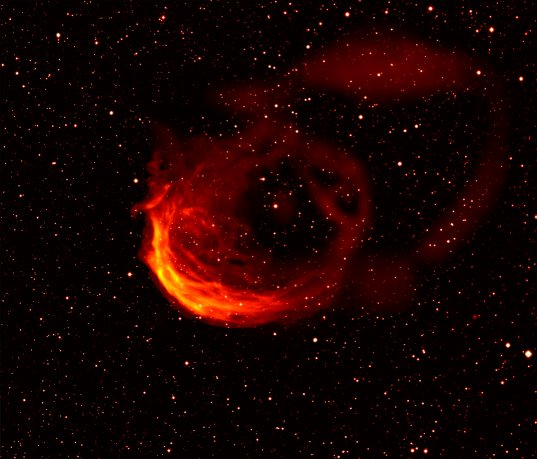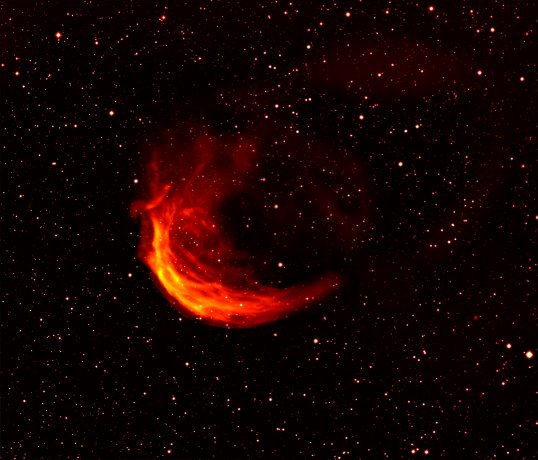DYING SUN-LIKE STARS LEAVE WHIRLPOOLS IN THEIR WAKE
19th April 2007

A movie showing a slice through the computer simulation parallel to the direction of motion of the star (Credit C.Wareing, University of Manchester). Click image to play movie.
Astronomers based at Jodrell Bank Observatory have found evidence that giant whirlpools form in the wake of stars as they move through clouds in interstellar space. The discovery will be presented by Dr Chris Wareing at the Royal Astronomical Society's National Astronomy Meeting in Preston on 17th April.
Dr Wareing and his colleagues used the COBRA supercomputer to simulate in three-dimensions the movement of a dying star through surrounding interstellar gas. At the end of their life, Sun-sized stars lose their grip on their outer layers and as much as half of their mass drifts off into space. The computer simulation modelled the collision between material given off by the star and the interstellar gas. It showed that a shockwave forms ahead of the dying star and giant eddies and whirlpools develop in the tail of material behind the star, similar to those seen in the wake of boats on open water. The group have now backed up these predictions with observations of the planetary nebula Sharpless 2-188 taken as part of the IPHAS (Isaac Newton Telescope Photometric H alpha Survey of the Northern Galactic Plane).
The central star of Sharpless 2-188 is 850 light years away and it is travelling at 125 kilometres per second across the sky. Observations show a strong brightening in the direction in which the star is moving and faint material stretching away in the opposite direction. Dr Wareing believes that the bright structures in the arc observed ahead of Sharpless 2-188 are the bowshock instabilities revealed in his simulations, which will form whirlpools as they spiral past the star downstream to the tail.

A combined image showing the bright regions and faint regions behind the bright arc. (Credit: N. Wright, University College London)
"These vortices can improve the mixing of the stellar material back into interstellar space, benefiting the next cycle of star formation. The turbulent whirlpools have an inherent spin, or angular momentum, which is an essential ingredient for the formation of the next generation of stars." said Dr Wareing who developed the computer model during his PhD and is now using it to understand the fate of our Sun.
Dying stars eject both gas and dust into space. The dust will coalesce into planets around later generations of stars. The gas contains carbon, necessary for life and produced inside stars. How the carbon, other gas and dust are ejected from the dying star is not well understood. The whirlpools in space can play an important role in mixing these essential ingredients into the interstellar gas from which further stars and planets will form.
FURTHER INFORMATION
IPHAS
IPHAS is a major survey of the Northern Galactic Plane being carried out with the 2.5-metre Isaac Newton Telescope (INT) in La Palma. The IPHAS survey began taking data with the INT Wide Field Camera in 2003 with the goal of imaging the entire northern galactic plane in the latitude range -5? < b < +5 degrees. Imaging of this 1800 sq. degree area should be completed by the end of 2007. http://www.iphas.org/
NOTES FOR EDITORS
Royal Astronomical Society's National Astronomy Meeting
The RAS National Astronomy Meeting is the UK's premier meeting for the astronomy, solar system and space science communities. The RAS-NAM 2007 is hosted by the University of Central Lancashire and is joined by the UK Solar Physics and Spring MIST meetings. It is sponsored by the Royal Astronomical Society, the UK Science and Technology Facilities Council and the University of Central Lancashire.
http://www.nam2007.uclan.ac.uk/info.php
Jodrell Bank Observatory
The Jodrell Bank Observatory is part of the School of Physics and Astronomy at The University of Manchester. The Observatory is home to the Lovell Radio Telescope and the MERLIN/VLBI National Facility which is operated by the University on behalf of Science and Technology Facilities Council. 2007 is the 50th Anniversary of the Lovell Space Telescope.
CONTACT INFORMATION:
This work was carried out by Dr Chris Wareing and collaborators as part of his STFC-funded Ph.D. project at Jodrell Bank under the supervision of Dr Tim O'Brien and as part of current post-doctoral research position at the University of Manchester.
Dr Chris Wareing is also the North West of England's Regional Co-ordinator for the Royal Institution's Science for Schools programme.
Dr Chris Wareing
School of Physics and Astronomy
The University of Manchester
Campus North
P.O. Box 88
Manchester
M60 1QD
E-mail: c.j.wareing@manchester.ac.uk
Tel: +44 (0) 7880 806 416
Web: www.jb.man.ac.uk/~cwareing
IPHAS: Principal Investigator and primary contact
Professor Janet Drew
Blackett Laboratory
Imperial College London
Exhibition Road
London
SW7 2AZ
E-mail: j.drew@imperial.ac.uk
Tel: 0044 (0) 207 594 7553
Fax: 0044 (0) 207 594 7541
http://astro.ic.ac.uk/Research/Halpha/North/index.shtml



